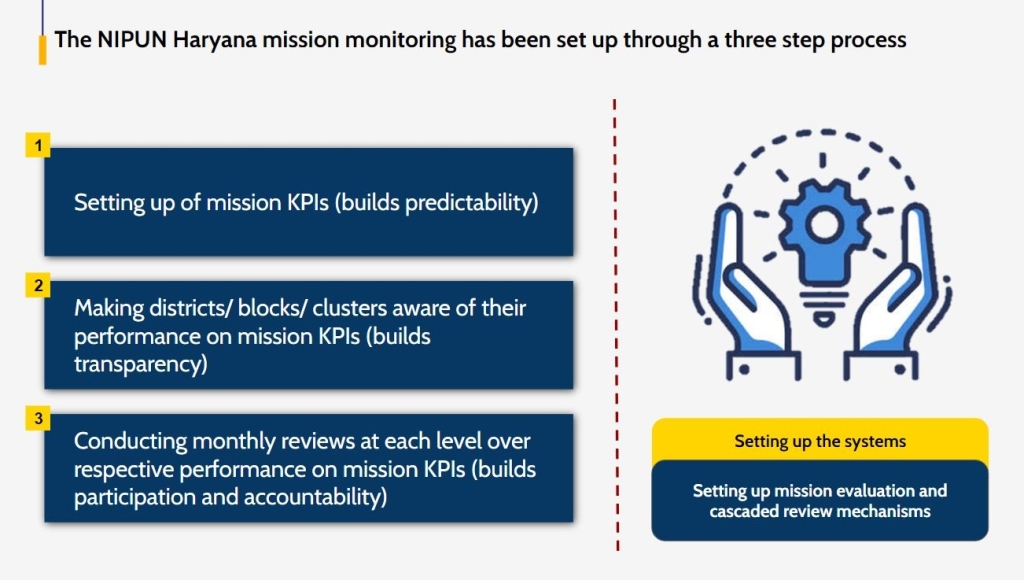The success of any mission is heavily dependent on its monitoring and evaluation mechanism. A comprehensive monitoring system can help in timely course correction, resource allocation, and provide an accurate picture of implementation and impact. The NIPUN Bharat Mission Guidelines (2021) recommend a strong review structure and an IT-based architecture for child-wise tracking. Following this, the NIPUN Haryana mission has implemented this approach by setting up personnel and review structures at state, district, and block level, supported by a comprehensive IT-based monitoring system that caters to all stakeholders.
Governance Bodies in the NIPUN Haryana Mission
At the state level, a steering committee chaired by the Additional Chief Secretary, School Education, conducts quarterly reviews to provide strategic guidance and critical analysis of the mission’s implementation. This is supported by the State Project Implementation Unit (SPIU), chaired by the State Project Director, which conducts monthly reviews to discuss work plans and implementation status in the districts.
Similar steering committees and implementation bodies have been established at the district level, with district steering committees chaired by the Deputy Commissioner, conducting quarterly reviews and District Project Implementation Units (DPIUs), chaired by the District Elementary Education Officer (DEEO), providing implementation support. Moreover, every district has a designated FLN Coordinator, who serves as a communication bridge between the state and district, assisting the DEEO in carrying out the mission at both the district and block level. These coordinators champion the mission at the district level by raising awareness and promoting its successful implementation across all levels of governance.
The NIPUN Bharat Mission Guidelines also suggest setting up of units at the block level. In Haryana, the last mile school policy and administration is conducted at the block level, which underscores the significance of building ownership of the mission at this level. To enable this, Block Project Implementation Units (BPIUs) have been set up which conduct mission review meetings at a monthly frequency.
Scorecard Backed Reviews

The review meetings at all levels are driven by the NIPUN scorecard, published monthly, at the district and block level. The NIPUN scorecard is based on selected Key Performance Indicators (KPIs), critical to the success of the NIPUN Haryana Mission, viz administration of weekly assessments, usage of student competency tracker, usage of student worksheets, print-richness in the classroom, and conduction of DPIU review. To further streamline the review process, a review template is shared with the district and block project implementation units. The blocks and districts send back the filled templates, illustrating the discussion on agenda points provided in the scorecard. Following the review meetings at the block and district level, the SPIU conducts a state-level review.

The collection of ground-level data by the mentor cadre in Haryana is crucial in creating the NIPUN scorecard. Currently, Google forms are used to collect scorecard data, which is then used to generate extensive, multi-level dashboards. However, from April 2023 onwards, the state will transition to using app-based tools for this purpose. The upcoming NIPUN Haryana app will include features such as classroom observation, feedback generation, student assessment, attendance, training management, and holistic progress tracking, all supported by intelligent reporting and dashboards at every level of governance.
Impact of Reviews in the NIPUN Haryana Mission

Since October 2022, the district scorecard-based reviews have been implemented in Haryana with great success. The reviews have not only directed district efforts towards key implementation levers but also provided a framework for conducting quality data-based reviews and facilitating decision-making. These scorecards have energized the districts and blocks, prompting them to take concrete, actionable steps to address their weaknesses. They are also keeping a close eye on school-level data and identifying underperforming schools for intervention. Additionally, these reviews have become spaces for discussing best practices, leading to the emergence of several new initiatives.
Conclusion
The implementation of a monitoring mechanism has invigorated the mission at both the district and block levels. Key stakeholders now have a clear understanding of the mission’s essential requirements and are focused on achieving its objectives. The mechanism has highlighted the crucial interventions necessary for improving learning outcomes both inside and outside the classroom. Once the full range of IT-based tools is made available, the monitoring mechanism will provide child-level data and real-time insights into student learning outcomes, enabling targeted interventions. The monitoring mechanism will thus cover all aspects of implementation, facilitating the mission’s progress towards achieving universal age-appropriate FLN skills in Haryana at scale.



